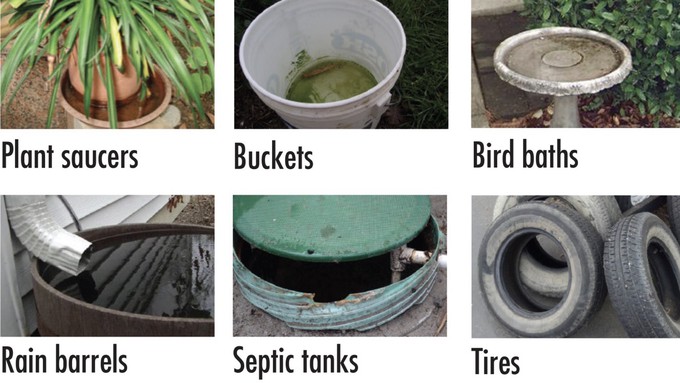
New invasive mosquito found in Sacramento County

These are just a few of the places where water collects outside -- and where mosquitoes can lay their eggs. Photos courtesy of Sacramento-Yolo Mosquito & Vector Control District
This Halloween, scary little monsters could be waiting to bite your arms and ankles – and some don’t wait until dark. They bite in broad daylight.
Mosquitoes seem to be particularly voracious this late October, ready to stick it to this evening’s trick-or-treaters. (They’ve certainly been nibbling on this gardener during late afternoons and evenings.)

An alert by the Sacramento-Yolo Mosquito & Vector Control District brings additional cause for alarm: The Asian tiger mosquito has been found for the first time in Sacramento County.
Aedes albopictus is the second invasive mosquito species to be detected in Sacramento County, joining the yellow fever mosquito (Aedes aegypti). Both are small, dark mosquitoes that bite aggressively during the day. And both have the potential to transmit deadly viruses.
This is how the vector experts found the first tiger mosquito, according to the district’s press release: “The initial detection came as a result of a call from a resident in Carmichael who had reported being bitten during the day. District staff conducted a backyard inspection and found a single mosquito larva in a watering can. In response to this initial finding, field technicians conducted door to door inspections in other homes throughout the neighborhood and found additional Aedes albopictus adult mosquitoes and larvae in surrounding areas.”
Both the tiger and yellow fever mosquitoes lay their eggs in all sorts of vessels – anything that can hold a few spoonfuls of water. When moisture collects in that container, the eggs hatch.
“Now that we have found this second species of invasive mosquitoes, our goal is to limit their expansion as best we can,” said district manager Gary Goodman. “We are mobilizing and responding quickly in order to protect the residents we serve.”
Besides both being day biters, both species of invasive mosquitoes can breed indoor or outdoors, making them doubly hard to control.
“They lay eggs above water in containers such as flower pots, pet dishes, bird baths, kids toys, tin cans, tires and other containers as small as a bottle cap that are commonly found in backyards,” says the vector district.
“Public cooperation is very important and we need your help,” said Goodman. “If you are being bitten by mosquitoes or notice them in your yard, please give the District a call to request a free inspection.”
Although they haven’t done it yet (at least as far as authorities know), both species can transmit several dangerous viruses including dengue, chikungunya, Zika and yellow fever. To do so, the insects need to bite someone carrying that virus.
In Carmichael, vector district field technicians will conduct door-to-door inspections to look for potential mosquito breeding sites, making appropriate treatments as necessary and talking to residents about preventive measures around their home, says the district.
Feel a bite or suspect a problem mosquito? Call 1-800-429-1022 or visit www.FIGHTtheBITE.net.
Meanwhile, wear long sleeves, long pants and mosquito repellent while outdoors. Better safe than bitten.
Comments
0 comments have been posted.Sacramento Digs Gardening to your inbox.
Sites We Like
Garden Checklist for week of May 5
Survey your garden after the May 4 rainstorm. Heavy rain and gusty winds can break the neck of large flowers such as roses. Also:
* Keep an eye on new transplants or seedlings; they could take a pounding from the rain.
* Watch out for powdery mildew. Warmth following moist conditions can cause this fungal disease to “bloom,” too. If you see a leaf that looks like it’s dusted with powdered sugar, snip it off.
* After the storm, start setting out tomato transplants, but wait on the peppers and eggplants (they want warmer nights). Pinch off any flowers on new transplants to make them concentrate on establishing roots instead of setting premature fruit.
* Trim dead flowers but not leaves from spring-flowering bulbs such as daffodils and tulips. Those leaves gather energy to create next year's flowers. Also, give the bulbs a fertilizer boost after bloom.
* Pinch chrysanthemums back to 12 inches for fall flowers. Cut old stems to the ground.
* Mulch around plants to conserve moisture and control weeds.
* From seed, plant beans, beets, cantaloupes, carrots, corn, cucumbers, melons, pumpkins, radishes and squash.
* Plant onion sets.
* In the flower garden, plant seeds for asters, cosmos, celosia, marigolds, salvia, sunflowers and zinnias. Transplant petunias, zinnias, geraniums and other summer bloomers.
* Plant perennials and dahlia tubers for summer bloom.
* Don’t wait; plant summer bulbs, such as gladiolus and tuberous begonias.
* Harvest cabbage, lettuce, peas and green onions.